Sizing and Design of a PV-Wind-Fuel Cell Storage System Integrated into a Grid Considering the Uncertainty of Load Demand Using the Marine Predators Algorithm
Abstract
1. Introduction
Installation Description
2. Mathematical Modeling
2.1. Modeling PV System
2.2. Modeling Wind Turbine System
2.3. Modeling Grid System
2.4. Modeling Electrolyzers
2.5. Modeling H2 Tank
2.6. Modeling FC
2.7. Modeling DC/AC Converter
2.8. Economical Evaluation of the Optimization Parameters
2.8.1. Loss of Power Supply Probability
2.8.2. Fluctuation of the Power Sold to the Grid
2.8.3. Cost of Energy (COE)
- Annual replacement cost: this cost appears when the lifetime of the components is shorter than the project lifetime.
- Annual operation and maintenance cost: This refers to the cost either required to operate a component of the hybrid system or used when any component needs repair.
- Penalty cost: This appears when the values of the fluctuation rate and LPSP exceed the predefined value. It is evaluated as follows:
- Annual purchasing cost of the main network: tit is the cost of power purchased from the grid and calculated using Equation (6).
- Annual cost of selling energy to the grid: it is the cost of the power sold to the electric grid and can be calculated using Equation (7).
3. Energy Management Strategy (Operation)
3.1. Constraints
3.2. Objective Function
4. Optimization Techniques
4.1. Seagull Optimization Algorithm (SOA)
The Mathematical Model
- Migration (exploration)
- Preventing collisions: collisions between other seagulls is avoided by updating their place using an additional parameter
- Movement to the best position: after preventing collisions with other individuals, the seagull moves toward the direction of the best search space. This can be explained as follows:
- Remaining close to the best search candidate: after the seagull moves toward the best position, its position can be updated to reach the new best position.
- 2.
- Attack of seagulls (exploitation)
4.2. Marine Predators Algorithm (MPA)
4.2.1. Exploration Phase
4.2.2. Intermediate Phase
- The first half of the population:
- The second half of the population
4.2.3. Exploitation Phase
5. Case Study
6. Simulation Results of the Hybrid System
7. Conclusions
Author Contributions
Funding
Institutional Review Board Statement
Informed Consent Statement
Data Availability Statement
Acknowledgments
Conflicts of Interest
Abbreviations
| PV | Photovoltaic. |
| MPA | Marine Predators’ algorithm. |
| SOA | Seagull optimization algorithm. |
| HRES | Hybrid Renewable Energy Systems. |
| RES | Renewable Energy System. |
| FCs | Fuel cells. |
| PSO | Particle Swarm Optimization. |
| BBA | Branch-Bound Algorithm. |
| GA | Genetic algorithm. |
| ICSA | Improved crow search algorithm. |
| RO | Robust optimization. |
| PM | Probabilistic method. |
| IGDT | Information gap decision theory. |
| HPP | Hybrid possibility probability method. |
| The generated power by solar PV cell and WT respectively. | |
| WTs | Wind turbines. |
| The total output power generated by a group of wind. turbines and solar PV cells respectively. | |
| The load demand power. | |
| The generated power by FC. | |
| The maximum power of PV modules. | |
| The number of solar PV cells and WTs. | |
| The wiring efficiency and the efficiency of the solar PV cells. | |
| The number of WTs and the WTs efficiency. The maximum power of the WTs. | |
| The temperature coefficient of the PV modules. | |
| The ambient of solar radiation. | |
| The Egyptian price for purchasing power from the utility, $/kWh. | |
| The purchasing power from the electric grid. | |
| The proceeds from selling power. | |
| The power sold to the grid. The Egyptian price (tariff rate) of selling power. | |
| The electrolyzer output power(kw). | |
| The electrolyzer input power(kw). | |
| The efficiency of the electrolyzer. | |
| The amount of energy kept in the tank at time t and time (t − 1). | |
| The power supplied to the FCs. | |
| The hydrogen tank efficiency. | |
| The higher heating value of hydrogen. | |
| The power input to the FC. | |
| The efficiency of the FC and the inverter respectively. | |
| The FC output power. The output power produced from RES. | |
| The FC input power. | |
| The fluctuation rates. | |
| Max and Min surplus power delivered to the main utility, respectively. | |
| COE | Energy cost. |
| The overall annual cost. | |
| The capital cost of every system component per annum, the replacement cost of every system component per annum, and cost for operation and maintenance every system component per annum, respectively. | |
| The annual cost of purchasing and selling energy to the grid, respectively. | |
| The initial capital cost of the wind turbine, FC, electrolyzer, hydrogen tank, PV module, and converter, respectively. | |
| The lifetime of the wind turbine module, FC, electrolyzer, hydrogen tank, PV module, and converter, respectively. | |
| i | The annual interest rate (%). |
| The capital recovery factor. | |
| The lifespan for each subsystem. | |
| Annual replacement cost. | |
| Replacement cost for individual system. | |
| The operation and maintenance cost of wind turbine, PV modules, FC, electrolyzer, hydrogen tank, and converter, respectively. | |
| The operating hours for PV, wind turbine, FC, Electrolyzer, hydrogen tank, and converter, respectively. | |
| The penalty costs. | |
| and | The penalty costs of the shortage and supply Fluctuation, respectively. |
| NPC | The net present cost. |
| The full and the minimum capacity of the hydrogen. | |
| Loss of power supply probability. | |
| The new position of candidates after preventing collision and the seagull’s initial position, respectively. | |
| The present iteration. | |
| The agent’s motion in the search space. | |
| The maximum number of iterations. | |
| The position in the direction of the best search seagull. | |
| The best position in the searching space at iteration y. | |
| The best-fit searching agent. | |
| The updating position of the seagulls. | |
| The initial value of the parameters. | |
| Lower and Upper boundaries of each variable. | |
| Current iteration and maximum iterations. |
References
- Liu, X.; Jin, Z. An analysis of the interactions between electricity, fossil fuel and carbon market prices in Guangdong, China. Energy Sustain. Dev. 2020, 55, 82–94. [Google Scholar] [CrossRef]
- Qarnain, S.S.; Muthuvel, S.; Bathrinath, S. Review on government action plans to reduce energy consumption in buildings amid COVID-19 pandemic outbreak. Mater. Today Proc. 2021, 45, 1264–1268. [Google Scholar] [CrossRef] [PubMed]
- Doshi, R.; Kute, V. A review paper on security concerns in cloud computing and proposed security models. In Proceedings of the 2020 International Conference on Emerging Trends in Information Technology and Engineering (IC-ETITE), Vellore, India, 24–25 February 2020. [Google Scholar]
- Hosseini Firouz, M.; Ghadimi, N. Optimal preventive maintenance policy for electric power distribution systems based on the fuzzy AHP methods. Complexity 2016, 21, 70–88. [Google Scholar] [CrossRef]
- Rajanna, S.; Saini, R. Modeling of integrated renewable energy system for electrification of a remote area in India. Renew. Energy 2016, 90, 175–187. [Google Scholar] [CrossRef]
- Samy, M.M.; Barakat, S. Hybrid invasive weed optimization-particle swarm optimization algorithm for biomass/PV micro-grid power system. In Proceedings of the 2019 21st International Middle East Power Systems Conference (MEPCON), Cairo, Egypt, 17–19 December 2019. [Google Scholar]
- Subudhi, P.S.; Krithiga, S. Wireless power transfer topologies used for static and dynamic charging of EV battery: A review. Int. J. Emerg. Electr. Power Syst. 2020, 21, 20190151. [Google Scholar] [CrossRef]
- Diab, A.A.Z.; El-Rifaie, A.M.; Zaky, M.M.; Tolba, M.A. Optimal sizing of stand-alone microgrids based on recent metaheuristic algorithms. Mathematics 2022, 10, 140. [Google Scholar] [CrossRef]
- Bekele, G.; Boneya, G. Design of a photovoltaic-wind hybrid power generation system for Ethiopian remote area. Energy Procedia 2012, 14, 1760–1765. [Google Scholar] [CrossRef]
- Belatrache, D.; Saifi, N.; Harrouz, A.; Bentouba, S. Modelling and Numerical Investigation of the thermal properties effect on the soil temperature in Adrar region. Alger. J. Renew. Energy Sustain. Dev. 2020, 2, 165–174. [Google Scholar] [CrossRef]
- Bhattacharjee, S.; Acharya, S. PV–wind hybrid power option for a low wind topography. Energy Convers. Manag. 2015, 89, 942–954. [Google Scholar] [CrossRef]
- Kaur, R.; Krishnasamy, V.; Kandasamy, N.K. Optimal sizing of wind–PV-based DC microgrid for telecom power supply in remote areas. IET Renew. Power Gener. 2018, 12, 859–866. [Google Scholar] [CrossRef]
- Khare, V.; Nema, S.; Baredar, P. Solar–wind hybrid renewable energy system: A review. Renew. Sustain. Energy Rev. 2016, 58, 23–33. [Google Scholar] [CrossRef]
- Mouli, G.C.; Bauer, P.; Zeman, M. System design for a solar powered electric vehicle charging station for workplaces. Appl. Energy 2016, 168, 434–443. [Google Scholar] [CrossRef]
- Nehrir, M.; Wang, C.; Strunz, K.; Aki, H.; Ramakumar, R.; Bing, J.; Miao, Z.; Salameh, Z. A review of hybrid renewable/alternative energy systems for electric power generation: Configurations, control, and applications. IEEE Trans. Sustain. Energy 2011, 2, 392–403. [Google Scholar] [CrossRef]
- Wang, L.; Singh, C. Multicriteria design of hybrid power generation systems based on a modified particle swarm optimization algorithm. IEEE Trans. Energy Convers. 2009, 24, 163–172. [Google Scholar] [CrossRef]
- Lei, G.; Song, H.; Rodriguez, D. Power generation cost minimization of the grid-connected hybrid renewable energy system through optimal sizing using the modified seagull optimization technique. Energy Rep. 2020, 6, 3365–3376. [Google Scholar] [CrossRef]
- Badr, M.A.E.S. Hybrid Wind and Solar Systems Optimization. In Modeling, Simulation and Optimization of Wind Farms and Hybrid Systems; IntechOpen: London, UK, 2020; p. 262. [Google Scholar]
- Barakat, S.; Ibrahim, H.; Elbaset, A.A. Multi-objective optimization of grid-connected PV-wind hybrid system considering reliability, cost, and environmental aspects. Sustain. Cities Soc. 2020, 60, 102178. [Google Scholar] [CrossRef]
- Das, D.; Esmaili, R.; Xu, L.; Nichols, D. An optimal design of a grid connected hybrid wind/photovoltaic/fuel cell system for distributed energy production. In Proceedings of the 31st Annual Conference of IEEE Industrial Electronics Society, IECON 2005, Raleigh, NC, USA, 6–10 November 2005; p. 6. [Google Scholar]
- Samy, M.M.; Mosaad, M.I.; Barakat, S. Optimal economic study of hybrid PV-wind-fuel cell system integrated to unreliable electric utility using hybrid search optimization technique. Int. J. Hydrog. Energy 2021, 46, 11217–11231. [Google Scholar] [CrossRef]
- Banhidarah, A.K.; Al-Sumaiti, A.S. Heuristic search algorithms for optimal locations and sizing of distributed generators in the grid: A brief recent review. In Proceedings of the 2018 Advances in Science and Engineering Technology International Conferences (ASET), Dubai, Sharjah, Abu Dhabi, United Arab Emirates, 6 February–5 April 2018; pp. 1–5. [Google Scholar]
- Yuan, G.; Gao, Y.; Ye, B.; Huang, R. Real-time pricing for smart grid with multi-energy microgrids and uncertain loads: A bilevel programming method. Int. J. Electr. Power Energy Syst. 2020, 123, 106206. [Google Scholar] [CrossRef]
- Dufo-López, R.; Bernal-Agustín, J.L.; Yusta-Loyo, J.M.; Domínguez-Navarro, J.A.; Ramírez-Rosado, I.J.; Lujano, J.; Aso, I. Multi-objective optimization minimizing cost and life cycle emissions of stand-alone PV–wind–diesel systems with batteries storage. Appl. Energy 2011, 88, 4033–4041. [Google Scholar] [CrossRef]
- Tafreshi, S.; Zamani, H.; Ezzati, S.; Baghdadi, M.; Vahedi, H. Optimal unit sizing of distributed energy resources in microgrid using genetic algorithm. In Proceedings of the 2010 18th Iranian Conference on Electrical Engineering, Isfahan, Iran, 11–13 May 2010; pp. 836–841. [Google Scholar]
- Hadidian-Moghaddam, M.; Arabi-Nowdeh, S.; Bigdeli, M. Optimal sizing of a stand-alone hybrid photovoltaic/wind system using new grey wolf optimizer considering reliability. J. Renew. Sustain. Energy 2016, 8, 035903. [Google Scholar] [CrossRef]
- Bilal, M.; Alsaidan, I.; Alaraj, M.; Almasoudi, F.M.; Rizwan, M. Techno-Economic and Environmental Analysis of Grid-Connected Electric Vehicle Charging Station Using AI-Based Algorithm. Mathematics 2022, 10, 924. [Google Scholar] [CrossRef]
- Moghaddam, S.; Bigdeli, M.; Moradlou, M. Optimal design of an off-grid hybrid renewable energy system considering generation and load uncertainty: The case of Zanjan city, Iran. SN Appl. Sci. 2021, 3, 732. [Google Scholar] [CrossRef]
- Yan, J.; Zhang, H.; Liu, Y.; Han, S.; Li, L. Uncertainty estimation for wind energy conversion by probabilistic wind turbine power curve modelling. Appl. Energy 2019, 239, 1356–1370. [Google Scholar] [CrossRef]
- Li, K.; Song, Y.; Wang, R. Multi-Objective Optimal Sizing of HRES under Multiple Scenarios with Undetermined Probability. Mathematics 2022, 10, 1508. [Google Scholar] [CrossRef]
- Ahn, H.; Rim, D.; Pavlak, G.S.; Freihaut, J.D. Uncertainty analysis of energy and economic performances of hybrid solar photovoltaic and combined cooling, heating, and power (CCHP+ PV) systems using a Monte-Carlo method. Appl. Energy 2019, 255, 113753. [Google Scholar] [CrossRef]
- Thevenard, D.; Pelland, S. Estimating the uncertainty in long-term photovoltaic yield predictions. Sol. Energy 2013, 91, 432–445. [Google Scholar] [CrossRef]
- Zubo, R.H.; Mokryani, G.; Rajamani, H.-S.; Aghaei, J.; Niknam, T.; Pillai, P. Operation and planning of distribution networks with integration of renewable distributed generators considering uncertainties: A review. Renew. Sustain. Energy Rev. 2017, 72, 1177–1198. [Google Scholar] [CrossRef]
- Samper, M.E.; Vargas, A. Investment decisions in distribution networks under uncertainty with distributed generation—Part II: Implementation and results. IEEE Trans. Power Syst. 2013, 28, 2341–2351. [Google Scholar] [CrossRef]
- Beza, T.M.; Wu, C.-H.; Kuo, C.-C. Optimal Sizing and Techno-Economic Analysis of Minigrid Hybrid Renewable Energy System for Tourist Destination Islands of Lake Tana, Ethiopia. Appl. Sci. 2021, 11, 7085. [Google Scholar] [CrossRef]
- Smaoui, M.; Krichen, L. Design and energy control of stand-alone hybrid wind/photovoltaic/fuel cell power system supplying a desalination unit. J. Renew. Sustain. Energy 2014, 6, 043111. [Google Scholar] [CrossRef]
- Ghenai, C.; Salameh, T.; Merabet, A. Technico-economic analysis of off grid solar PV/Fuel cell energy system for residential community in desert region. Int. J. Hydrog. Energy 2020, 45, 11460–11470. [Google Scholar] [CrossRef]
- Khan, M.J.; Mathew, L.; Alotaibi, M.A.; Malik, H.; Nassar, M.E. Fuzzy-Logic-Based Comparative Analysis of Different Maximum Power Point Tracking Controllers for Hybrid Renewal Energy Systems. Mathematics 2022, 10, 529. [Google Scholar] [CrossRef]
- Diab, A.A.Z.; Sultan, H.M.; Mohamed, I.S.; Kuznetsov, O.N.; Do, T.D. Application of different optimization algorithms for optimal sizing of PV/wind/diesel/battery storage stand-alone hybrid microgrid. IEEE Access 2019, 7, 119223–119245. [Google Scholar] [CrossRef]
- Diab, A.A.Z.; Sultan, H.M.; Kuznetsov, O.N. Optimal sizing of hybrid solar/wind/hydroelectric pumped storage energy system in Egypt based on different meta-heuristic techniques. Environ. Sci. Pollut. Res. 2020, 27, 32318–32340. [Google Scholar] [CrossRef]
- Yang, H.; Wei, Z.; Chengzhi, L. Optimal design and techno-economic analysis of a hybrid solar–wind power generation system. Appl. Energy 2009, 86, 163–169. [Google Scholar] [CrossRef]
- Mousa, H.H.; Youssef, A.-R.; Mohamed, E.E. Variable step size P&O MPPT algorithm for optimal power extraction of multi-phase PMSG based wind generation system. Int. J. Electr. Power Energy Syst. 2019, 108, 218–231. [Google Scholar]
- Asadi Bagal, H.; Mir Mousavi, M.m.; Janghorban Lariche, M.; Mohammadinodoushan, M.; Hayati, H. Wind power penetration impact on power system frequency. Int. J. Ambient. Energy 2019, 40, 455–462. [Google Scholar] [CrossRef]
- Malheiro, A.; Castro, P.M.; Lima, R.M.; Estanqueiro, A. Integrated sizing and scheduling of wind/PV/diesel/battery isolated systems. Renew. Energy 2015, 83, 646–657. [Google Scholar] [CrossRef]
- Diab, A.A.Z.; El-ajmi, S.I.; Sultan, H.M.; Hassan, Y.B. Modified farmland fertility optimization algorithm for optimal design of a grid-connected hybrid renewable energy system with fuel cell storage: Case study of Ataka, Egypt. Int. J. Adv. Comput. Sci. Appl. 2019, 10, 119–132. [Google Scholar] [CrossRef]
- Ott, S.; Orfanidi, A.; Schmies, H.; Anke, B.; Nong, H.N.; Hübner, J.; Gernert, U.; Gliech, M.; Lerch, M.; Strasser, P. Ionomer distribution control in porous carbon-supported catalyst layers for high-power and low Pt-loaded proton exchange membrane fuel cells. Nat. Mater. 2020, 19, 77–85. [Google Scholar] [CrossRef] [PubMed]
- Singla, M.K.; Nijhawan, P.; Oberoi, A.S. Hydrogen fuel and fuel cell technology for cleaner future: A review. Environ. Sci. Pollut. Res. 2021, 28, 15607–15626. [Google Scholar] [CrossRef]
- Singla, M.K.; Nijhawan, P.; Oberoi, A.S. Parameter estimation of proton exchange membrane fuel cell using a novel meta-heuristic algorithm. Environ. Sci. Pollut. Res. 2021, 28, 34511–34526. [Google Scholar] [CrossRef]
- Singla, M.K.; Nijhawan, P.; Oberoi, A.S. Cost–benefit comparison of fuel cell–based and battery-based renewable energy systems. Int. J. Energy Res. 2022, 46, 1736–1755. [Google Scholar] [CrossRef]
- Xu, L.; Ruan, X.; Mao, C.; Zhang, B.; Luo, Y. An improved optimal sizing method for wind-solar-battery hybrid power system. IEEE Trans. Sustain. Energy 2013, 4, 774–785. [Google Scholar]
- Dhiman, G.; Kumar, V. Seagull optimization algorithm: Theory and its applications for large-scale industrial engineering problems. Knowl.-Based Syst. 2019, 165, 169–196. [Google Scholar] [CrossRef]
- Sattar, M.A.E.; Al Sumaiti, A.; Ali, H.; Diab, A.A.Z. Marine predators algorithm for parameters estimation of photovoltaic modules considering various weather conditions. Neural Comput. Appl. 2021, 33, 11799–11819. [Google Scholar] [CrossRef]
- Askari, Q.; Younas, I.; Saeed, M. Political Optimizer: A novel socio-inspired meta-heuristic for global optimization. Knowl.-Based Syst. 2020, 195, 105709. [Google Scholar] [CrossRef]

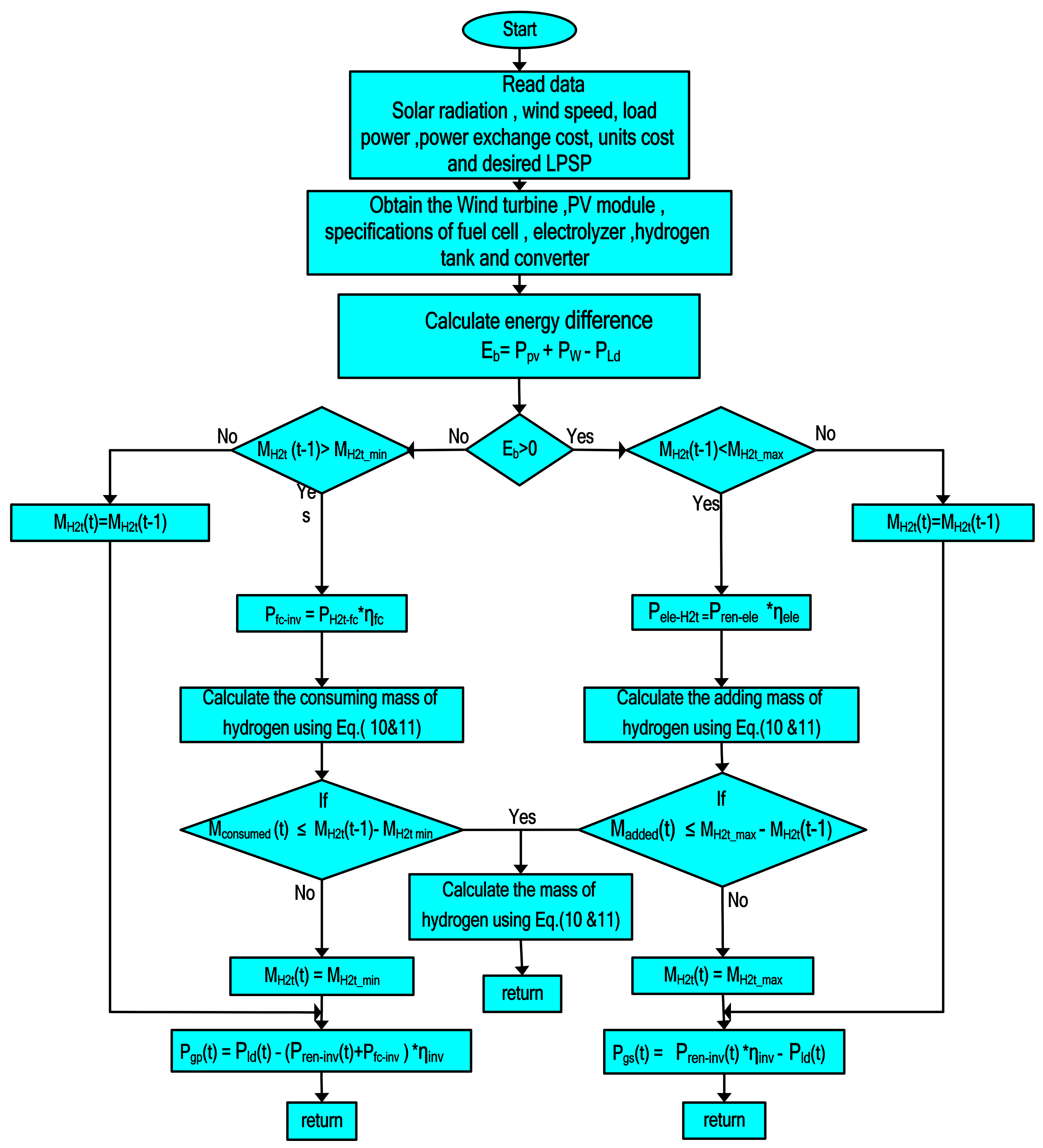

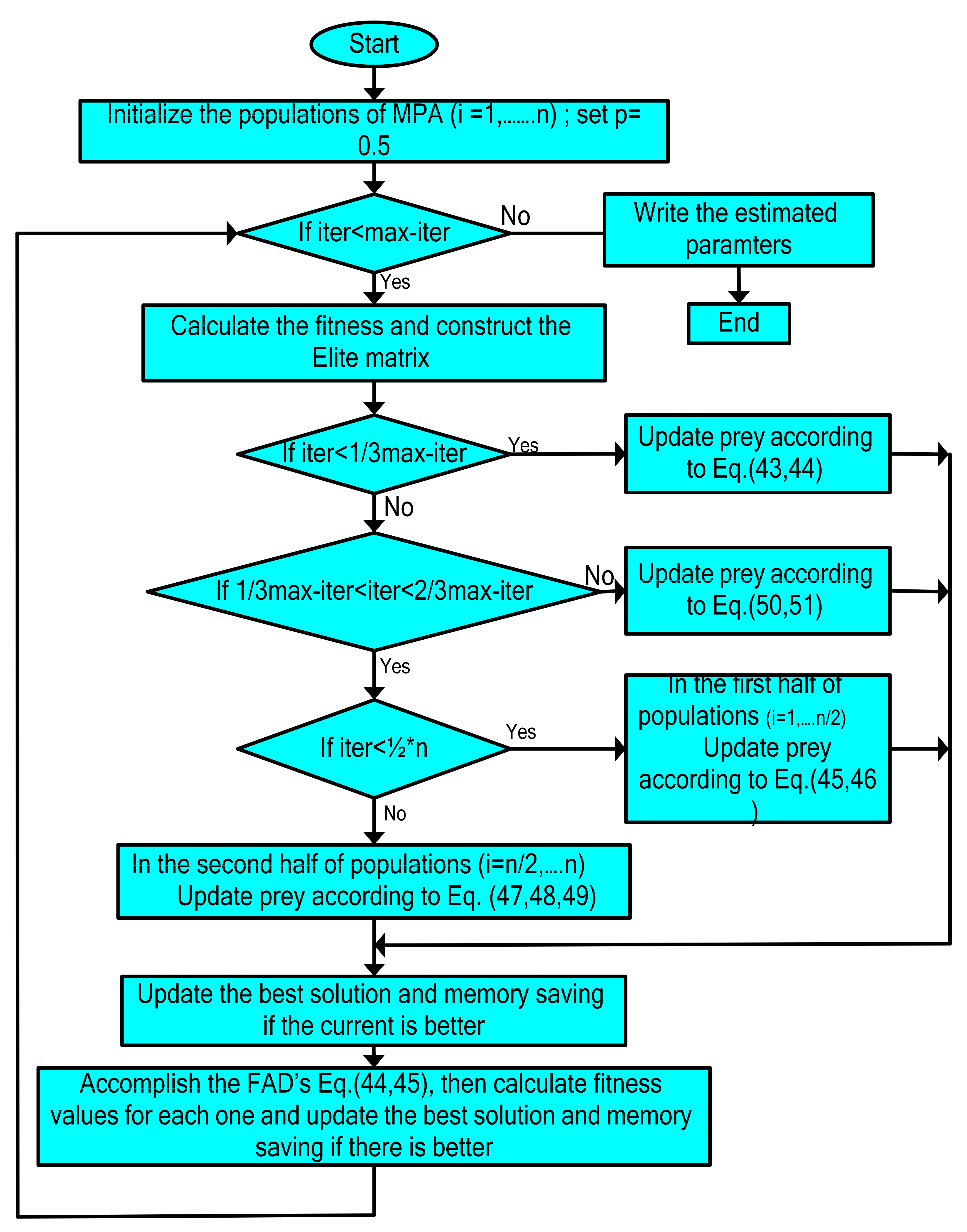
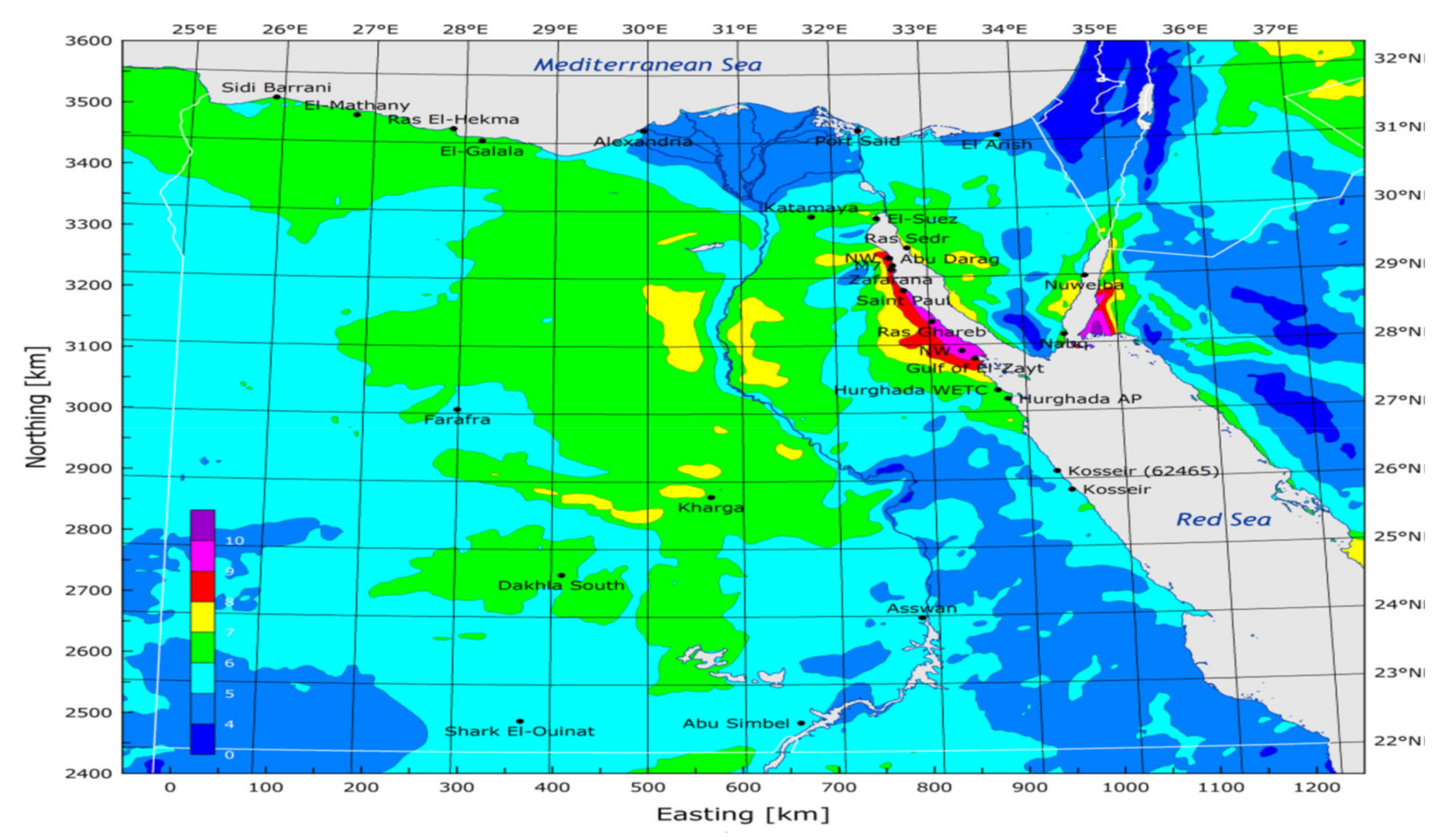
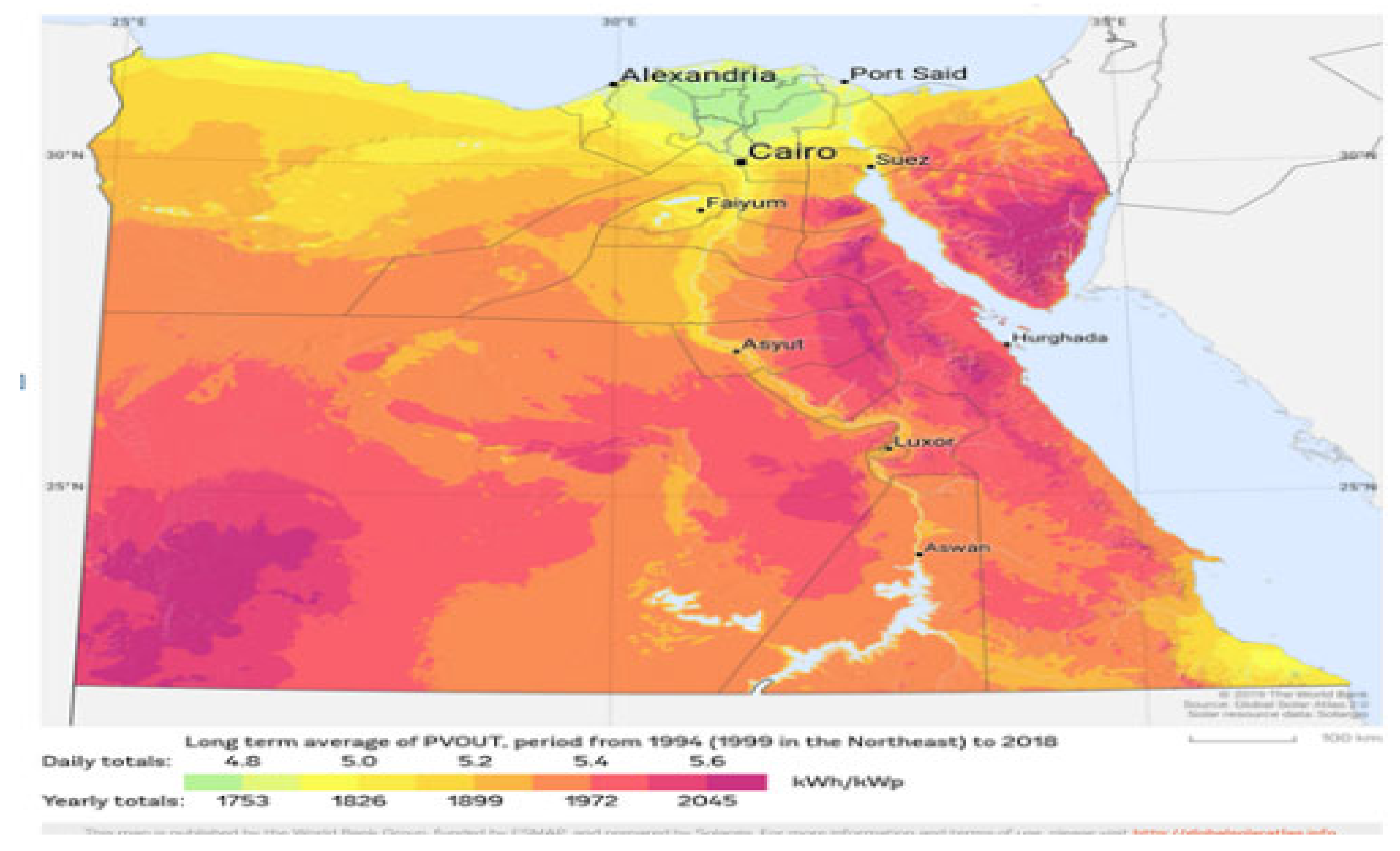
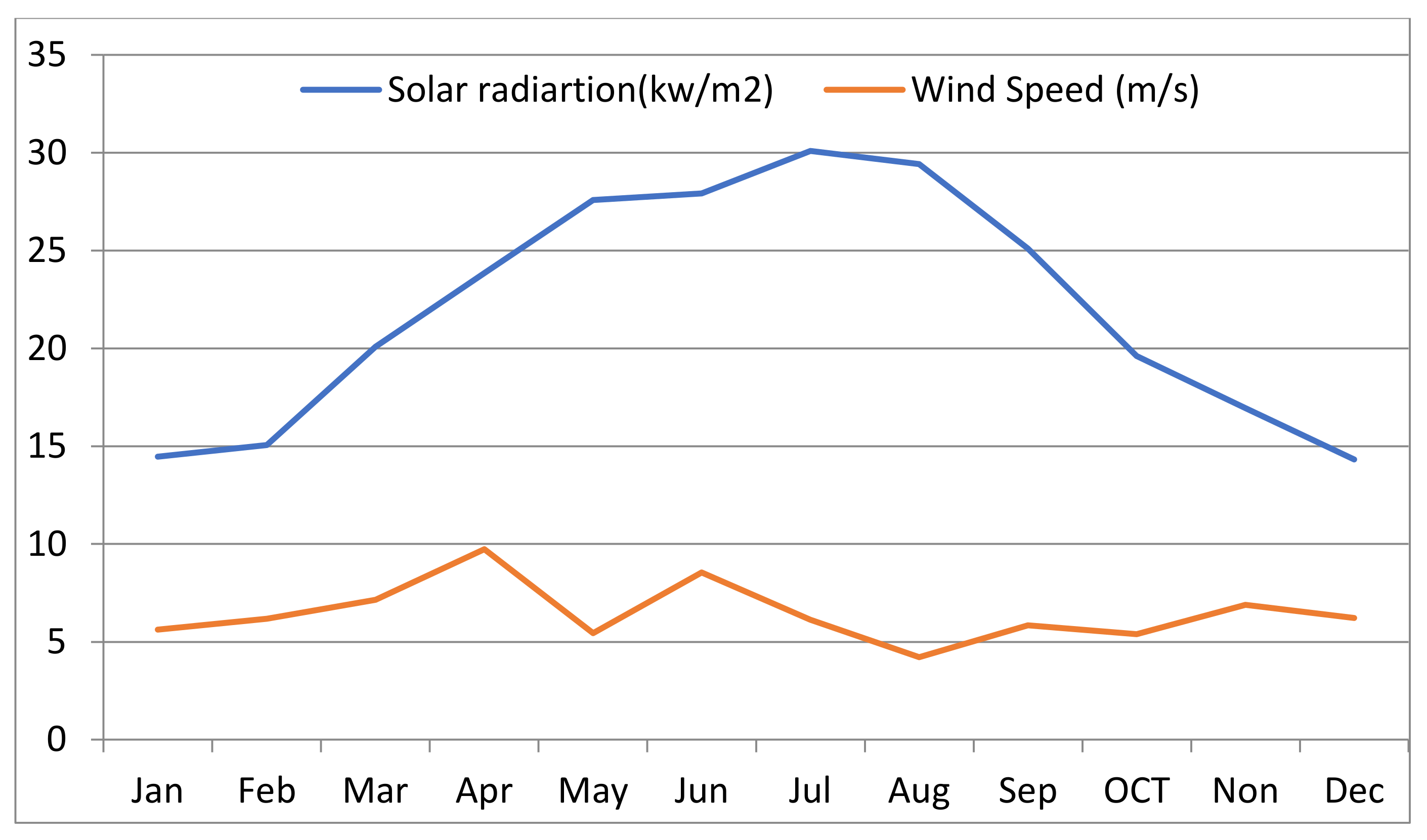



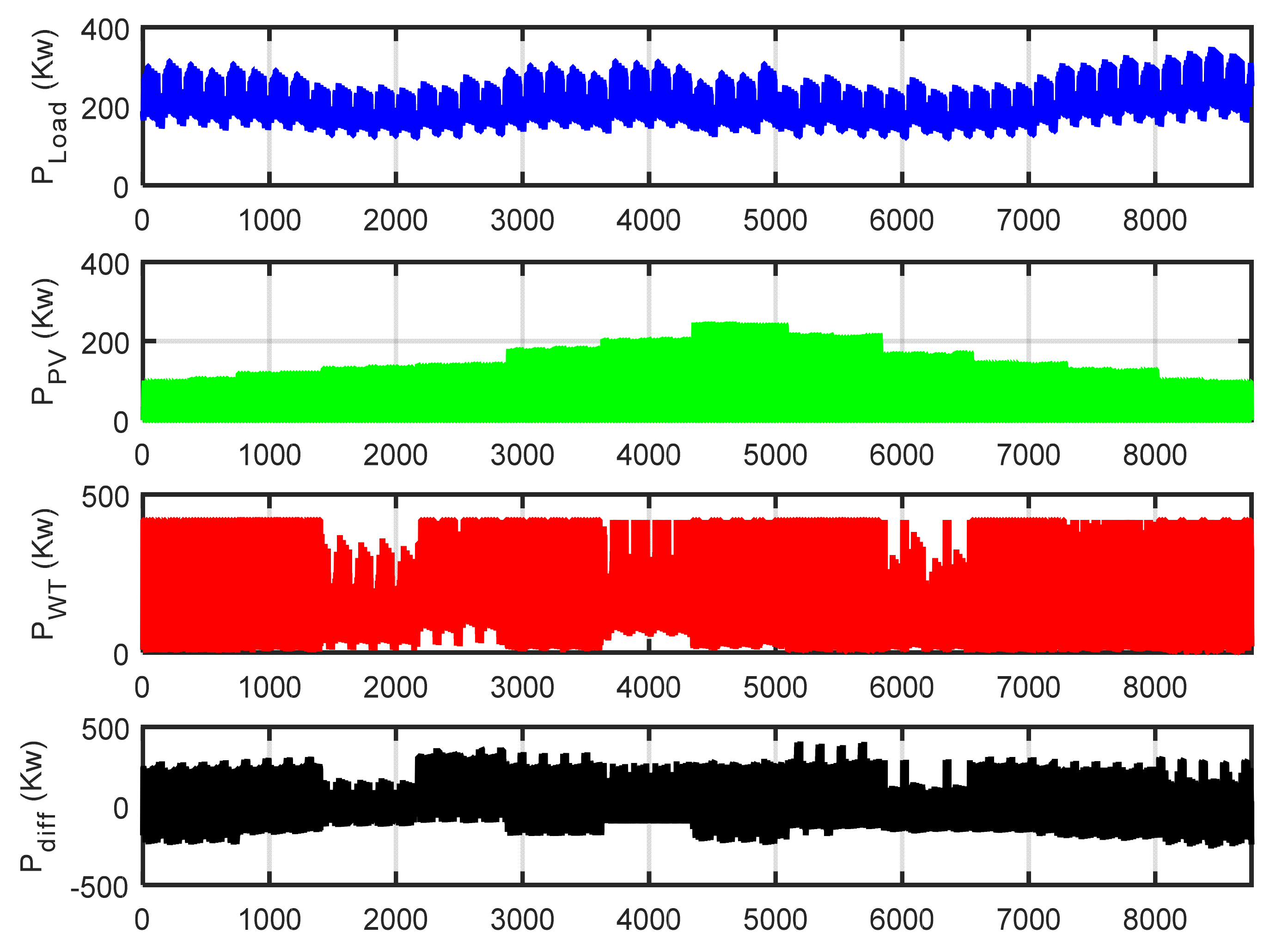
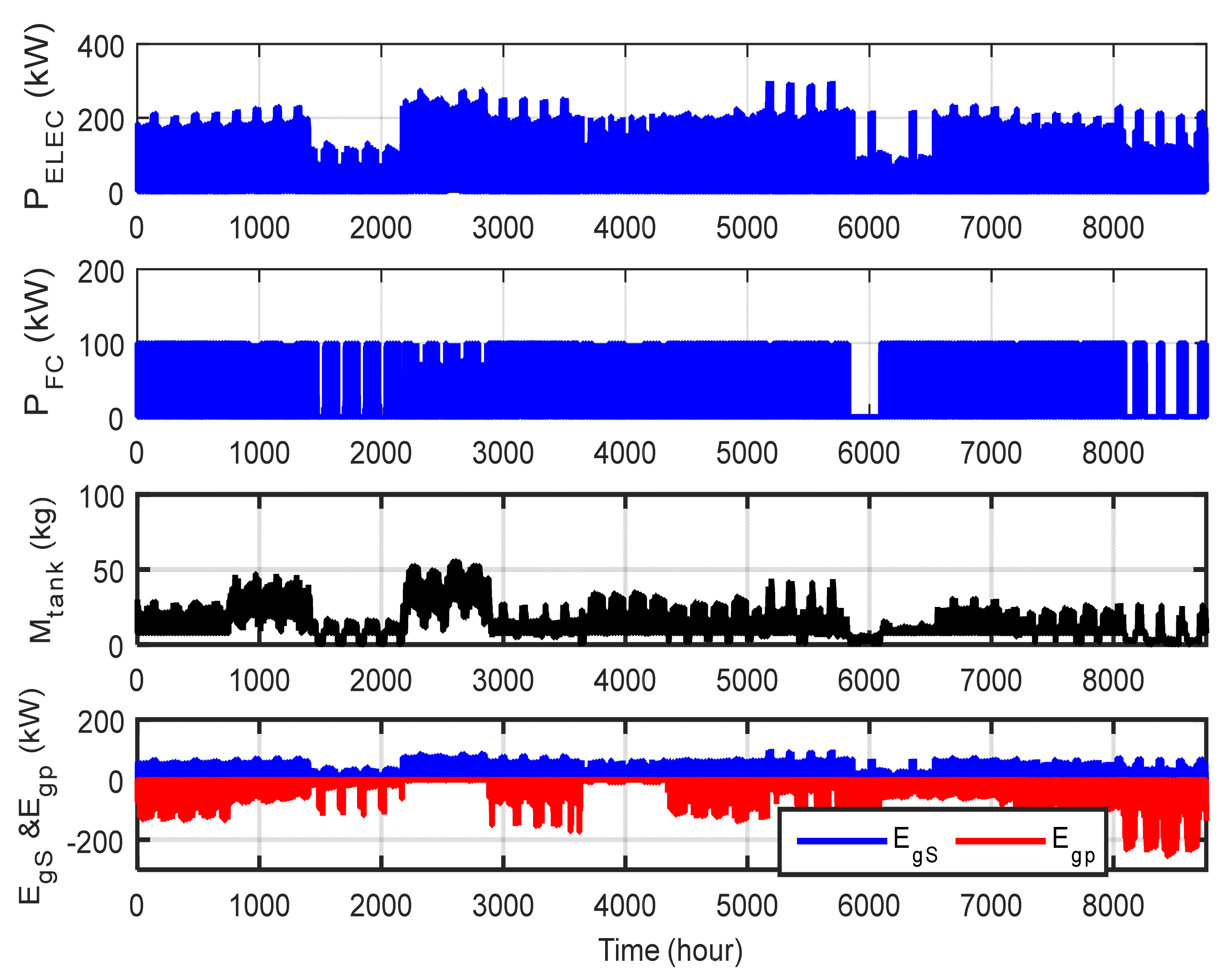


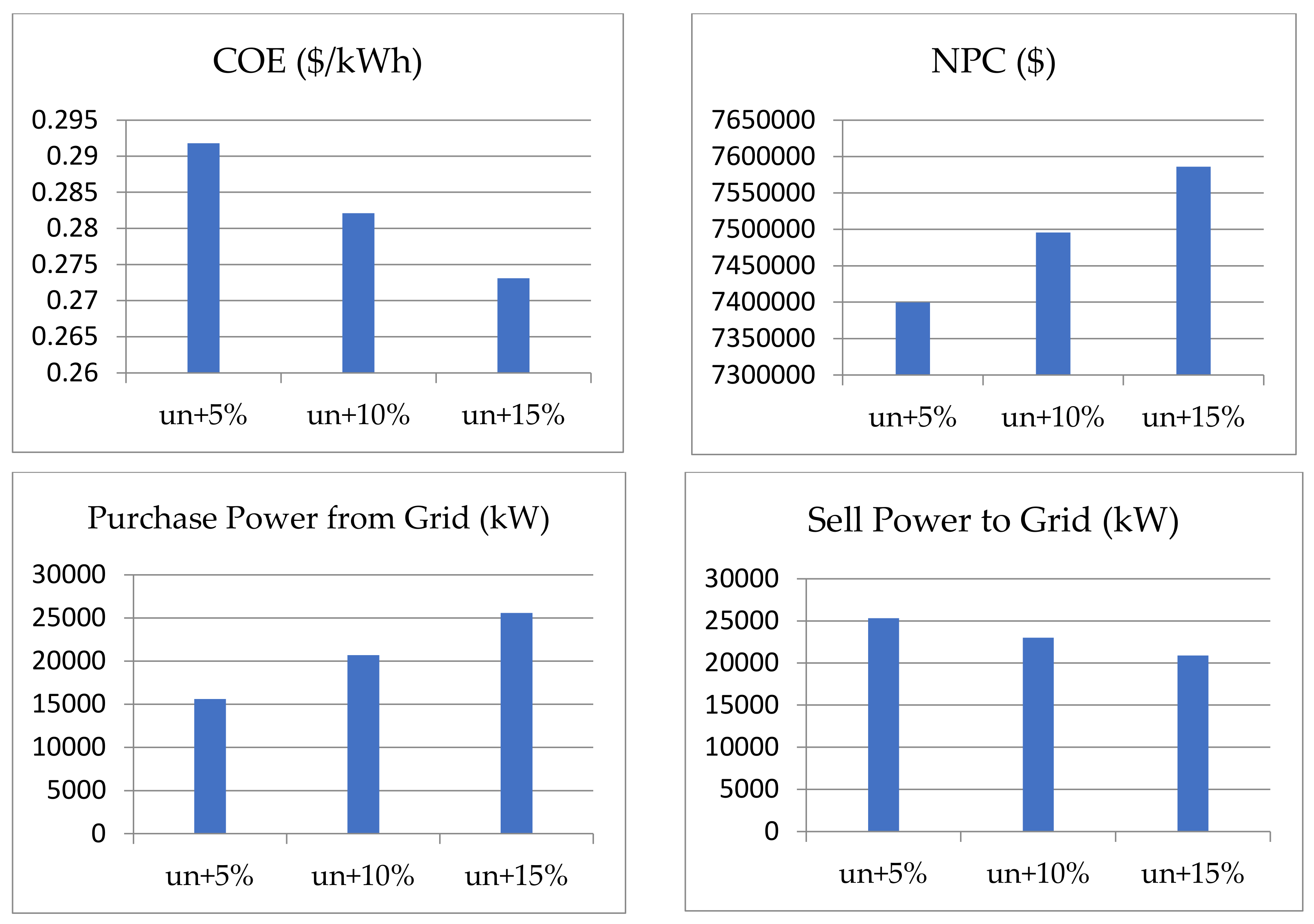
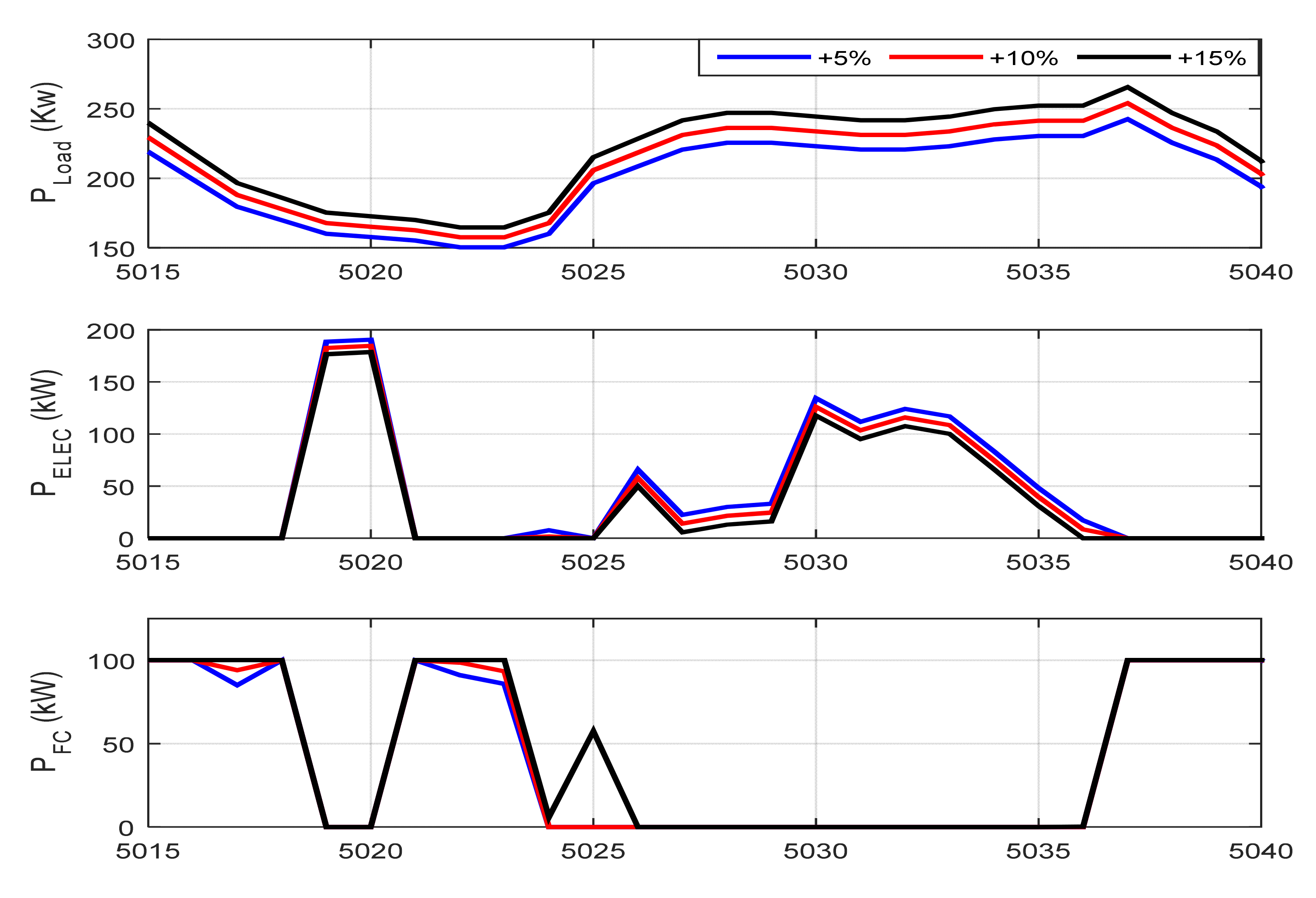
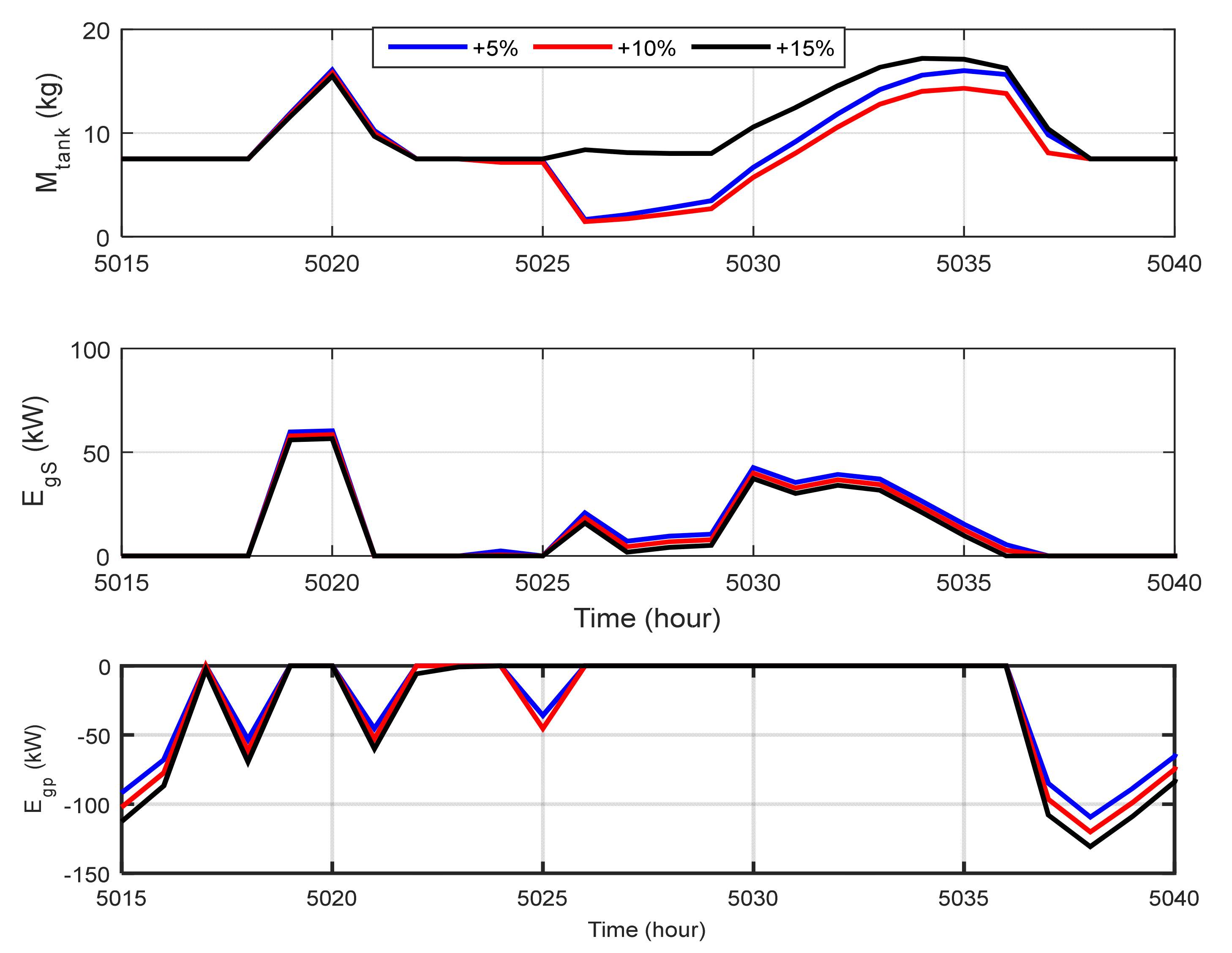
| Parameters | Wind Turbine | PV Array | Elctrolyzer | Hydrogen Tank | Fuel Cell | Inverter |
|---|---|---|---|---|---|---|
| Capital cost (US$/unit) | ||||||
| Replacement cost (US$/unit) | ||||||
| (US$/unit-yr) | ||||||
| Lifetime(year) |
| Items | Optimal Solution | ||
|---|---|---|---|
| MPA | SOA | PSO | |
| Best objective function | 1.0102 | 1.0169 | 1.46433350572227 |
| n _PVs | 250 | 250 | 500 |
| n _WT | 70 | 70 | 70 |
| Electrolyzer rated power (kW) | 300 | 300 | 442.6293 |
| Mass of the H2 tanks (kg) | 150 | 150 | 135.7179 |
| FC rated power kW) | 100 | 100 | 250 |
| Inverter rated power (kW) | 150 | 150 | 510.4037 |
| Number of iterations to attain an optimal solution | 5 | 3 | PSO does not reach to the optimum. |
| COE ($/kWh) | 0.3044 | 0.3115 | 0.5176 |
| LPSP | −4.883 × 10−18 | −9.7063 × 10−19 | −3.461 × 10−15 |
| NPC ($) | 7.350895 × 106 | 7.523017 × 106 | 1.2498 × 107 |
| Sold power to the grid () | 27.82 × 103 | 27.821 × 103 | 5.0515 × 104 |
| Purchased power from the grid ( | 14.22 × 103 | 27.737 × 103 | 2.7878 × 103 |
| Items | Load Uncertainty | ||
|---|---|---|---|
| +5% | +10% | +15% | |
| Best objective function | 1.0102 | 1.0102 | 1.0102 |
| n_PVs | 250 | 250 | 250 |
| n_WT | 70 | 70 | 70 |
| Electrolyzer rated power of (kW) | 300 | 300 | 300 |
| Mass of the H2 tanks (kg) | 150 | 150 | 150 |
| FC rated power kW) | 100 | 100 | 100 |
| Inverter rated power (kW) | 150 | 150 | 150 |
| Number of iterations to attain an optimal solution | 7 | 4 | 9 |
| COE ($/kWh) | 0.2918 | 0.2821 | 0.2731 |
| LPSP | −4.285 × 10−18 | −5.328 × 10−18 | −5.6198 × 10−18 |
| NPC ($) | 7.399616 × 106 | 7.495652 × 106 | 7.586028 × 106 |
| Sold power to the grid () | 25.321 × 103 | 23.005 × 103 | 20.893 × 103 |
| Purchased power from the grid ( | 15.585 × 103 | 20.729 × 103 | 25.568 × 103 |
Publisher’s Note: MDPI stays neutral with regard to jurisdictional claims in published maps and institutional affiliations. |
© 2022 by the authors. Licensee MDPI, Basel, Switzerland. This article is an open access article distributed under the terms and conditions of the Creative Commons Attribution (CC BY) license (https://creativecommons.org/licenses/by/4.0/).
Share and Cite
Mahmoud, F.S.; Abdelhamid, A.M.; Al Sumaiti, A.; El-Sayed, A.-H.M.; Diab, A.A.Z. Sizing and Design of a PV-Wind-Fuel Cell Storage System Integrated into a Grid Considering the Uncertainty of Load Demand Using the Marine Predators Algorithm. Mathematics 2022, 10, 3708. https://doi.org/10.3390/math10193708
Mahmoud FS, Abdelhamid AM, Al Sumaiti A, El-Sayed A-HM, Diab AAZ. Sizing and Design of a PV-Wind-Fuel Cell Storage System Integrated into a Grid Considering the Uncertainty of Load Demand Using the Marine Predators Algorithm. Mathematics. 2022; 10(19):3708. https://doi.org/10.3390/math10193708
Chicago/Turabian StyleMahmoud, Fayza S., Ashraf M. Abdelhamid, Ameena Al Sumaiti, Abou-Hashema M. El-Sayed, and Ahmed A. Zaki Diab. 2022. "Sizing and Design of a PV-Wind-Fuel Cell Storage System Integrated into a Grid Considering the Uncertainty of Load Demand Using the Marine Predators Algorithm" Mathematics 10, no. 19: 3708. https://doi.org/10.3390/math10193708
APA StyleMahmoud, F. S., Abdelhamid, A. M., Al Sumaiti, A., El-Sayed, A.-H. M., & Diab, A. A. Z. (2022). Sizing and Design of a PV-Wind-Fuel Cell Storage System Integrated into a Grid Considering the Uncertainty of Load Demand Using the Marine Predators Algorithm. Mathematics, 10(19), 3708. https://doi.org/10.3390/math10193708







